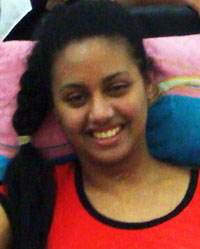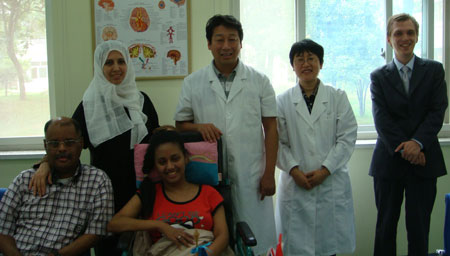Rasees Al-abdallah - Sequela of spinal cord injury (Saudi Arabia) Posted on January 30, 2012
Name: Rasees Al-abdallah 
Sex: Female
Country:Saudi Arabia
Age: 21
Diagnosis: Sequela of spinal cord injury
Admission Date: 2011-11-06
Days Admitted to Hospital: 21
Rasees was involved in a car accident and immediately lost the movement in the arms and legs. There was also sensory deprivation. Rasees was sent to a local hospital for treatment as a result, and the X-ray examination showed that she had a fracture at the cervical vertebrae 5 and 6. She received surgery 3 days later. After the surgery, there was some movement in the hands. Two months later, she went to a local hospital for physical rehabilitation therapy. The arms gained back much of their movement ability. Currently she can raise her arms but there is still some resistance. Rasees was put on medication to decrease the muscle tension, improve her mood, and she received anticoagulants. Rasees came to our medical center in August 2011. After the completion of the treatment, the motor and sensory functioning had improved.
At the time of Reese's admission the skin and mucosa were normal. The respiratory sounds in both lungs were clear. The heart rate was regular, with no murmur in the auscultatory valve area. The abdomen was smooth. The liver and spleen were not palpable. There was obvious muscle atrophy in both hands and legs. There was a surgical scar on the front left area of the neck and the right anterior superior iliac spine, the scar was about 3cms long.
During the nervous system examination, there was horizontal nystagmus in the right eye. The upper limbs' adductor muscle strength was level 4 and the abductor muscle strength was level 2. The upper limbs were stable when being raised. The fingers on both hands had difficulty with movements. The index finger and thumb on both hands had only slight movement. The left lower limb had slight voluntary movement. The muscle tone of both upper limbs was between level 1and level 2. The muscle tone of both lower limbs was slightly higher. There was obvious involuntary flexion movements when both lower limbs were stimulated. The tendon reflexes of the upper limbs were almost normal. The tendon reflexes of the lower limbs were not elicited. The abdominal reflex was not elicited. The sensation above the C7 spinal cord segment was normal. The superficial sensation between the C8 and T1 segments was diminished. The superficial sensation between the T2 and T4 segments was normal. The superficial sensation below the T4 segment was diminished. The deep sensation below the T7 segment was diminished. The right side Hoffmann's sign was positive, the left side Hoffmann's sign was negative. The right side Babinski's sign was positive. Rasees was unable to complete the finger-to-nose test, the heel-knee-shin test or the rapid rotation test.
We initially gave Rasees a complete examination and she was diagnosed with a spinal cord injury. Then we proceeded with the nerve nutrition, and improved the blood circulation in order to increase the blood supply to the damaged neurons. This was combined with daily physical rehabilitation training. Rasees took oral blood lipid lowering medication to control the abnormally high level.
After the completion of the treatment, the muscle strength of both upper limbs' distal-end had increased. The arms are now stable when they are raised. The adduction strength of the arms has reached level 4+, and the abduction strength has reached level 3-. The control of the movements of both legs is better, and the proximal-end muscle strength has more noticeably increased. The muscle strength of the left leg has increased to between level 2 and level 3. The muscle strength of the right leg has increased to level 2. The left knee can be raised off the surface of the bed to 3 cms. The legs have faster movement ability. The reflexes of the mid-abdominal area and the hypogastrium can be elicited. The tuning fork vibration sensation can reach the lumbosacral location, and the positioning is accurate. The acupuncture sensation on the right side has been reduced to the thoracic segment 5. The acupuncture sensation on the left side has been reduced to the thoracic segment 7. But there is still a difference in feeling with the normal acupuncture sensation.

See Rasees' Video
(Download the Windows Media Player Firefox Plugin if you are using Firefox browser.
To know more,Please read Using the Windows Media Player plugin with Firefox.)
